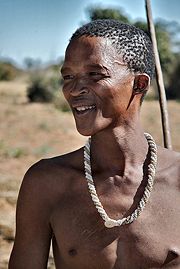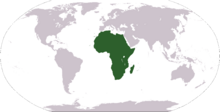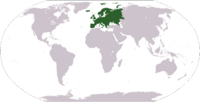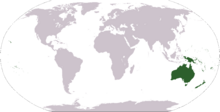Indigenous peoples
The term indigenous peoples or autochthonous peoples can be used to describe any ethnic group of people who inhabit a geographic region with which they have the earliest historical connection, alongside migrants which have populated the region and which are greater in number. [1] However, several widely-accepted formulations, which define the term "indigenous peoples" in stricter terms, have been put forward by prominent and internationally-recognized organizations, such as the United Nations, the International Labour Organization and the World Bank. Indigenous peoples in this article is used in such a narrower sense.
Drawing on these, a contemporary working definition of "indigenous peoples" for certain purposes has criteria which would seek to include cultural groups (and their continuity or association with a given region, or parts of a region, and who formerly or currently inhabit the region either:
- before its subsequent colonization or annexation; or
- alongside other cultural groups during the formation of a nation-state; or
- independently or largely isolated from the influence of the claimed governance by a nation-state,
and who furthermore:
- have maintained at least in part their distinct linguistic, cultural and social/organizational characteristics, and in doing so remain differentiated in some degree from the surrounding populations and dominant culture of the nation-state.
To the above, a criterion is usually added to also include:
- peoples who are self-identified as indigenous, and/or those recognised as such by other groups.
Note that even if all the above criteria are fulfilled, some people may either not consider themselves as indigenous or may not be considered as indigenous by governments, organizations or scholars.
Other related terms for indigenous peoples include aborigines (æbəˈɹɪdʒɪni), aboriginal peoples, native peoples, first peoples, first nations and autochthonous (this last term having a derivation from Greek, meaning "sprung from the earth"). Indigenous peoples may often be used in preference to these or other terms, as a neutral replacement where these terms may have taken on negative or pejorative connotations by their prior association and use. It is the preferred term in use by the United Nations and its subsidiary organizations.
Contents |
Definitions
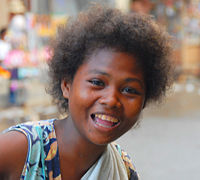
The adjective indigenous has the common meaning of "having originated in and being produced, growing, living, or occurring naturally in a particular region or environment".[3] Therefore, in a purely adjectival sense any given people, ethnic group or community may be described as being indigenous in reference to some particular region or location.
Key to a contemporary understanding of 'indigenousness' is the political role an ethnic group plays, for all other criteria usually taken to denote Indigenous groups (territory, race, history, subsistence lifestyle, etc.) can to a greater or lesser extent also be applied to majority cultures. Therefore, the distinction applied to Indigenous ethnic groups can be formulated as: “a politically underprivileged group, who share a similar ethnic identity different to the nation in power, and who have been an ethnic entity in the locality before the present ruling nation took over power” (Greller, 1997).
However, the specific term indigenous peoples has a more restrictive interpretation when it used in the more formalised, legalistic and academic sense, associated with the collective rights of human populations. In these contexts, the term is used to denote particular peoples and groups around the world who, as well as being native to or associated with some given territory, meet certain other criteria (such as having reached a social and technological plateau thousands of years ago). This article is concerned with the latter, and not the former, sense of the term.
Characteristics of indigenous people
Population and distribution

Indigenous societies range from those who have been significantly exposed to the colonizing or expansionary activities of other societies (such as the Maya peoples of Mexico and Central America) through to those who as yet remain in comparative isolation from any external influence (such as the Sentinelese and Jarawa of the Andaman Islands).

Precise estimates for the total population of the world's Indigenous peoples are very difficult to compile, given the difficulties in identification and the variances and inadequacies of available census data. Recent source estimates range from 300 million[4] to 350 million[5] as of the start of the 21st century. This would equate to just under 6% of the total world population. This includes at least 5000 distinct peoples[6] in over 72 countries.
Contemporary distinct indigenous groups survive in populations ranging from only a few dozen to hundreds of thousands or more. Many indigenous populations have undergone a dramatic decline and even extinction, and remain threatened in many parts of the world. Some have also been assimilated by other populations or have undergone many other changes. In other cases, Indigenous populations are undergoing a recovery or expansion in numbers.
Certain indigenous societies survive even though they may no longer inhabit their "traditional" lands, owing to migration, relocation, forced resettlement or having been supplanted by other cultural groups. In many other respects, the transformation of culture of indigenous groups is ongoing, and includes permanent loss of language, loss of lands, encroachment on traditional territories, and disruption in traditional lifeways due to contamination and pollution of waters and lands.
Common characteristics
Characteristics common across many Indigenous groups include present or historical reliance upon subsistence-based production (based on pastoral, horticultural and/or hunting and gathering techniques), and a predominantly non-urbanized society. Indigenous societies may be either settled in a given locale/region or exhibit a nomadic lifestyle across a large territory. Indigenous societies are found in every inhabited climate zone and continent of the world.
Common concerns
Indigenous peoples confront a diverse range of concerns associated with their status and interaction with other cultural groups, as well as changes in their inhabited environment. Some challenges are specific to particular groups; however, other challenges are commonly experienced. Bartholomew Dean and Jerome Levi (2003) explore why and how the circumstances of Indigenous peoples are improving in some places of the world, while their human rights continue to be abused in others.[7] These issues include cultural and linguistic preservation, land rights, ownership and exploitation of natural resources, political determination and autonomy, environmental degradation and incursion, poverty, health, and discrimination.
The interaction between Indigenous and non-indigenous societies throughout history has been complex, ranging from outright conflict and subjugation to some degree of mutual benefit and cultural transfer. A particular aspect of anthropological study involves investigation into the ramifications of what is termed first contact, the study of what occurs when two cultures first encounter one another. The situation can be further confused when there is a complicated or contested history of migration and population of a given region, which can give rise to disputes about primacy and ownership of the land and resources.
Historical indigenous cultures
The migration, expansion and settlement of societies throughout different territories is a universal, almost defining thread which runs through the entire course of human history. Many of the cross-cultural interactions which arose as a result of these historical encounters involved societies which might properly be considered as indigenous, either from their own viewpoint or that of external societies.
Most often, these past encounters between Indigenous and "non-indigenous" groups lack contemporary account or description. Any assessment or understanding of impact, result and relation can at best only be surmised, using archaeological, linguistic or other reconstructive means. Where accounts do exist, they frequently originate from the viewpoint of the colonizing, expansionary or nascent state.
Classical antiquity
Greek sources of the Classical period acknowledge the prior existence of Indigenous people(s), whom they referred to as "Pelasgians." These peoples inhabited lands surrounding the Aegean Sea before the subsequent migrations of the Hellenic ancestors claimed by these authors. The disposition and precise identity of this former group is elusive, and sources such as Homer, Hesiod and Herodotus give varying, partially mythological accounts. However, it is clear that cultures existed whose indigenous characteristics were distinguished by the subsequent Hellenic cultures (and distinct from non-Greek speaking "foreigners", termed "barbarians" by the historical Greeks).
European expansion and colonialism
The rapid and extensive spread of the various European powers from the early 18th century onwards had a profound impact upon many of the indigenous cultures with whom they came into contact. The exploratory and colonial ventures in the Americas, Africa, Asia and the Pacific often resulted in territorial and cultural conflict, and the intentional or unintentional displacement and devastation of the indigenous populations.
Europe
The Canary Islands had an Indigenous population called the Guanches whose origin is still the subject of discussion among historians and linguists.[8]
Contemporary distribution and survey
- See also: List of indigenous peoples
Indigenous populations are distributed in regions throughout the globe. The numbers, condition and experience of indigenous groups may vary widely within a given region. A comprehensive survey is further complicated by sometimes contentious membership and identification.
Africa
- See also: Category:Indigenous peoples of Africa
In the post-colonial period, the concept of specific Indigenous peoples within the African continent has gained wider acceptance, although not without controversy. The highly-diverse and numerous ethnic groups which comprise most modern, independent African states contain within them various peoples whose situation, cultures and pastoralist or hunter-gatherer lifestyles are generally marginalised and set apart from the dominant political and economic structures of the nation. Since the late 20th century these peoples have increasingly sought recognition of their rights as distinct Indigenous peoples, in both national and international contexts.
Although the vast majority of African peoples can be considered to be indigenous in the sense that they have originated from that continent and nowhere else, in practice identity as an "Indigenous people" as per the term's modern application is more restrictive, and certainly not every African ethnic group claims identification under these terms. Groups and communities who do claim this recognition are those who by a variety of historical and environmental circumstances have been placed outside of the dominant state systems, and whose traditional practices and land claims often come into conflict with the objectives and policies promulgated by governments, companies and surrounding dominant societies.

Given the extensive and complicated history of human migration within Africa, being the "first peoples in a land" is not a necessary pre-condition for acceptance as an indigenous people. Rather, Indigenous identity relates more to a set of characteristics and practices than priority of arrival. For example, several populations of nomadic peoples such as the Tuareg of the Sahara and Sahel regions now inhabit areas in which they arrived comparatively recently; their claim to Indigenous status (endorsed by the African Commission on Human and Peoples' Rights) is based on their marginalisation as nomadic peoples in states and territories dominated by sedentary agricultural peoples.

The Indigenous Peoples of Africa Co-ordinating Committee (IPACC) is one of the main trans-national network organizations recognised as a representative of African indigenous peoples in dialogues with governments and bodies such as the UN. IPACC identifies several key characteristics associated with indigenous claims in Africa:
- political and economic marginalisation rooted in colonialism;
- de facto discrimination based often on the dominance of agricultural peoples in the State system (e.g. lack of access to education and health care by hunters and herders);
- the particularities of culture, identity, economy and territoriality that link hunting and herding peoples to their home environments in deserts and forests (e.g. nomadism, diet, knowledge systems);
- some indigenous peoples, such as the San and Pygmy peoples are physically distinct, which makes them subject to specific forms of discrimination.
With respect to concerns expressed that identifying some groups and not others as indigenous is in itself discriminatory, IPACC states that it:
- "...recognises that all Africans should enjoy equal rights and respect. All of Africa’s diversity is to be valued. Particular communities, due to historical and environmental circumstances, have found themselves outside the state-system and underrepresented in governance...This is not to deny other Africans their status; it is to emphasise that affirmative recognition is necessary for hunter-gatherers and herding peoples to ensure their survival."

At an African inter-governmental level, the examination of indigenous rights and concerns is pursued by a sub-commission established under the African Commission on Human and Peoples' Rights (ACHPR), sponsored by the African Union (AU) (successor body to the Organisation of African Unity (OAU)). In late 2003 the 53 signatory states of the ACHPR adopted the Report of the African Commission's Working Group on Indigenous Populations/Communities and its recommendations. This report says in part (p. 62):
- ...certain marginalized groups are discriminated in particular ways because of their particular culture, mode of production and marginalized position within the state[; a] form of discrimination that other groups within the state do not suffer from. The call of these marginalized groups to protection of their rights is a legitimate call to alleviate this particular form of discrimination.
The adoption of this report at least notionally subscribed the signatories to the concepts and aims of furthering the identity and rights of African Indigenous peoples. The extent to which individual states are mobilising to put these recommendations into practice varies enormously, however, and most Indigenous groups continue to agitate for improvements in the areas of land rights, use of natural resources, protection of environment and culture, political recognition and freedom from discrimination.
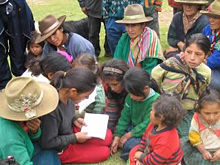
The Americas
- See also: Category:Indigenous peoples of the Americas
Indigenous peoples of the American continents are broadly recognised as being those groups and their descendants who inhabited the region before the arrival of European colonizers and settlers (i.e., Pre-Columbian). Indigenous peoples who maintain, or seek to maintain, traditional ways of life are found from the high Arctic north to the southern extremities of Tierra del Fuego.

The impact of European colonization of the Americas on the Indigenous communities has been in general quite severe, with many authorities estimating ranges of significant population decline due to the ravages of various genocide campaigns,epidemic diseases (smallpox, measles, etc), displacement, conflict, compulsory boarding schools, massacres and exploitation. The extent of this impact is the subject of much continuing debate. Several peoples shortly thereafter became extinct, or very nearly so.
All nations in North and South America have populations of Indigenous peoples within their borders. In some countries (particularly Latin American), Indigenous peoples form a sizeable component of the overall national population--in Bolivia they account for an estimated 56%-70% of the total nation, and at least half of the population in Guatemala and the Andean and Amazonian nations of Peru. In English, Indigenous peoples are collectively referred to by several different terms which vary by region and include such ethnoynms as Native Americans, Amerindians, Indians. In Spanish or Portuguese speaking countries one finds the use of terms such as pueblos indígenas, povos, nativos, Indígenas, and in Peru, Comunidades Nativas, particularly among Amazonian societies like the Urarina and Matsés.
The Aboriginal peoples in Canada include the First Nations, Inuit, and Métis. The combined Indigenous population is over a million (1,172,790). This means they represent 3.8% of the Canadian population. Their status is recognized by Canada's Constitution Act, 1982.[10] The Inuit have achieved a degree of administrative autonomy with the creation in 1999 of the territories of Nunavik (in Northern Quebec), Nunatsiavut (in Northern Labrador) and Nunavut, which was until 1999 a part of the Northwest Territories. The self-administering Danish territory of Greenland is also home to a majority population of Indigenous Inuit (about 85%).

In the United States, the combined populations of Native Americans, Inuit and other Indigenous designations totalled 2,786,652 (constituting about 1.5% of 2003 US census figures). Some 563 scheduled tribes are recognized at the Federal level, and a number of others recognized at the State level.
In Mexico, approximately 6,011,202 (constituting about 6.7% of 2005 Mexican census figures) identify as Indígenas (Spanish for natives or Indigenous peoples). In the southern states of Chiapas, Yucatan and Oaxaca they constitute 26.1%, 33.5% and 35.3%, respectively, of the population. In these states several conflicts and episodes of civil war have been conducted, in which the situation and participation of Indigenous societies were notable factors (see for example EZLN).
The Amerindians make up 0.4% of Brazil's population, or about 700,000 people.[11] Indigenous peoples are found in the entire territory of Brazil, although the majority of them live in Indian reservations in the North and Centre-Western part of the country. On 18 January 2007, FUNAI reported that it had confirmed the presence of 67 different uncontacted tribes in Brazil, up from 40 in 2005. With this addition Brazil has now overtaken the island of New Guinea as the country having the largest number of uncontacted tribes.[12]
Guatemala is 50 to 80% Indigenous, depending on whose statsitics are used (Nelson, Finger in the Wound 1999)
Asia
- See also: Category:Indigenous peoples of Asia
The vast regions of Asia contain the majority of the world's present-day Indigenous populations, about 70% according to IWGIA figures.
The most substantial populations are in India, which constitutionally recognises a range of "Scheduled Tribes" within its borders. These various peoples (collectively referred to as Adivasis, or tribal peoples) number about 68 million (1991 census figures, approximately 8% of the total national population).
The languages of Taiwanese aborigines have significance in historical linguistics, since in all likelihood Taiwan was the place of origin of the entire Austronesian language family, which is spread across the whole of Oceania.[14][15][16]
Indigenous peoples of Iran include the Bakhtiari, Laks, Lurs, Kurds, and Qashqai. The Assyrians and Marsh Arabs are also indigenous to areas of the geocultural region of Mesopotamia which includes parts of Iraq, Syria, and Turkey. The Lurs also inhabit parts of Iraq close to the Iranian border with the provinces of Lorestan and Ilam.
Ainu people are an ethnic group indigenous to Hokkaidō, the Kuril Islands, and much of Sakhalin. As Japanese settlement expanded, the Ainu were pushed northward, until by the Meiji period they were confined by the government to a small area in Hokkaidō, in a manner similar to the placing of Native Americans on reservations.[17]
Europe
- See also: Category:Indigenous peoples of Europe and European ethnic groups

Since most of Europe in historical times was never colonized by non-European powers with lasting effect (arguably except for Hungary, Turkish Thrace, Tatarstan, Kalmykia and islands such as Malta or Cyprus[18]), the vast majority of Europeans can be considered "indigenous". However several widely-accepted formulations, which define the term "Indigenous peoples" in stricter terms, have been put forward by important internationally-recognised organizations, such as the United Nations, the International Labour Organization and the World Bank. Indigenous peoples in this article is used in such a narrower sense.
In Europe, present-day recognized Indigenous populations are relatively few, mainly confined to northern and far-eastern reaches of this Eurasian peninsula. Whilst there are various ethnic minorities distributed within European countries, few of these still maintain traditional subsistence cultures and are recognized as indigenous peoples, per se. Notable indigenous populations include the Sami people of northern Scandinavia, the Nenets and other Samoyedic peoples of the northern Russian Federation, and the Komi peoples of the western Urals.
The Basque people, Indigenous people who inhabit northern Spain and southwestern France, are the oldest Indigenous ethnic group in Europe. The main theory about Basque origins suggests that they are a remnant of Paleolithic Europeans inhabiting continuously the Franco-Cantabrian region since at least Magdalenian times, and maybe as early as the original colonization of Europe by Homo sapiens. The only archaeological evidence for an invasion of the Basque Country dates to some 40,000 years ago when Cro-Magnon people first arrived in Europe and superseded Homo neanderthalensis.[19]
Caucasus is unique in its ethnic diversity, with a greater variety of languages spoken there than in any region of similar size in the world. Caucasus region is the home of over 50 indigenous ethnic groups.[20][21]
Oceania

- See also: Category:Indigenous peoples of Oceania
Many of the present-day Pacific Island nations in the Oceania region were originally populated by Polynesian, Melanesian and Micronesian peoples over the course of thousands of years. European colonial expansion in the Pacific brought many of these under non-indigenous administration. During the 20th century several of these former colonies gained independence and nation-states were formed under local control. However, various peoples have put forward claims for Indigenous recognition where their islands are still under external administration; examples include the Chamorros of Guam and the Northern Marianas, and the Marshallese of the Marshall Islands.
The remains of at least 25 miniature humans, who lived between 1,000 and 3,000 years ago, were recently found on the islands of Palau in Micronesia.[22]
In most parts of Oceania, indigenous peoples outnumber the descendents of colonists. Exceptions include Australia, New Zealand and Hawaii. According to the 2001 Australian census, Indigenous Australians make up 2.4% of the total population, while in New Zealand 14.6% of the population identify at least partially as indigenous Māori, with slightly more than half (53%) of all Māori residents identifying solely as Māori. Indigenous Hawaiians make up nearly a quarter of the general Hawaiian population.
The independent state of Papua New Guinea (PNG) has a majority population of indigenous societies, with some 700+ different tribal groups recognised out of a total population of just over 5 million. The PNG Constitution and other Acts identify traditional or custom-based practices and land tenure, and explicitly sets out to promote the viability of these traditional societies within the modern state. However, several conflicts and disputes concerning land use and resource rights continue to be observed between indigenous groups, the government and corporate entities.
Indigenous rights, issues and concerns
Wherever Indigenous cultural identity is asserted, some particular set of societal issues and concerns may be voiced which either arise from (at least in part), or have a particular dimension associated with, their indigenous status. These concerns will often be commonly held or affect other societies also, and are not necessarily experienced uniquely by indigenous groups.
Despite the diversity of Indigenous peoples, it may be noted that they share common problems and issues in dealing with the prevailing, or invading, society. They are generally concerned that the cultures of Indigenous peoples are being lost and that indigenous peoples suffer both discrimination and pressure to assimilate into their surrounding societies. This is borne out by the fact that the lands and cultures of nearly all of the peoples listed at the end of this article are under threat. Notable exceptions are the Sakha and Komi peoples (two of the Northern Indigenous Peoples of Siberia), who now control their own autonomous republics within the Russian state, and the Canadian Inuit, who form a majority of the territory of Nunavut (created in 1999).
It is also sometimes argued that it is important for the human species as a whole to preserve a wide range of cultural diversity as possible, and that the protection of indigenous cultures is vital to this enterprise.
An example of this occurred in 2002 when the Government of Botswana expelled all the Kalahari Bushmen known as the San from their lands [2] on which they had lived for at least twenty thousand years [3]. President Festus Mogai has described the Bushmen as "stone age creatures" [4] and a minister for local government, Margaret Nasha, likened public criticism of their eviction to criticism of the culling of elephants [5]. In 2006, the Botswanan High Court ruled that the Bushmen had a right to return to their land in the Central Kalahari Game Reserve [6][7].
In response, many have pointed out that in many cases the indigenous peoples often haven't been living self-sufficiently in an area for centuries, and that economic development was not an issue before because it was not an option.
Representation
The rights, claims and even identity of indigenous peoples are apprehended, acknowledged and observed quite differently from government to government. Various organizations exist with charters to in one way or another promote (or at least acknowledge) indigenous aspirations, and indigenous societies have often banded together to form bodies which jointly seek to further their communal interests.
In cooperation, representatives of Indigenous peoples have met in The World Council of Indigenous Peoples (WCIP), which held its first conference in British Columbia in 1975. Cooperation has continued in the research and education organization The Center for World Indigenous Studies (CWIS), founded in 1984, in Olympia, Washington, USA.
United Nations
Indigenous peoples and their interests are represented in the United Nations primarily through the mechanisms of the Working Group on Indigenous Populations (WGIP). In April 2000 the United Nations Commission on Human Rights adopted a resolution to establish the United Nations Permanent Forum on Indigenous Issues (PFII) as an advisory body to the Economic and Social Council with a mandate to review indigenous issues.
In late December 2004, the United Nations General Assembly proclaimed 2005-2014 to be the Second International Decade of the World's Indigenous People. The main goal of the new decade will be to strengthen international cooperation around resolving the problems faced by indigenous people in areas such as culture, education, health, human rights, the environment, and social and economic development.
In September 2007, after a process of preparations, discussions and negotiations stretching back to 1982, the General Assembly adopted the Declaration on the Rights of Indigenous Peoples. The non-binding declaration outlines the individual and collective rights of indigenous peoples, as well as their rights to identity, culture, language, employment, health, education and other issues. Four nations with significant indigenous populations voted against the declaration: the United States, Canada, New Zealand and Australia. Eleven nations abstained: Azerbaijan, Bangladesh, Bhutan, Burundi, Colombia, Georgia, Kenya, Nigeria, Russia, Samoa and Ukraine. Thirty-four nations did not vote, while the remaining 143 nations voted for it.
Other accredited organizations
Various organizations are devoted to the preservation or study of indigenous peoples. Of these, several have widely-recognized credentials to act as an intermediary or representative on behalf of indigenous peoples' groups, in negotiations on indigenous issues with governments and international organizations. These include:
- African Commission on Human and Peoples' Rights (ACHPR)
- Society for Threatened Peoples International (STP)
- International Work Group for Indigenous Affairs (IWGIA)
- Indigenous Peoples of Africa Co-ordinating Committee (IPACC)
- Movement in the Amazon for Tribal Subsistence and Economic Sustainability
- Survival International
- Indigenous Dialogues
- Center for World Indigenous Studies
- Cultural Survival
- Incomindios Switzerland
International Day of the World's Indigenous People
The International Day of the World's Indigenous People falls on August 9 as this was the date of the first meeting in 1982 of the United Nations Working Group of Indigenous Populations of the Subcommission on Prevention of Discrimination and Protection of Minorities of the Commission on Human Rights.
The UN General Assembly decided on 23 December 1994, that the International Day of the World’s Indigenous People should be observed on August 9 every year during the International Decade of the World’s Indigenous People (resolution 49/214). Later on 20 December 2004 the assembly decided to continue observing the International Day of Indigenous People every year during the Second International Decade of the World's Indigenous People (2005-2014) (resolution 59/174).[23]
Indigenous knowledge and culture
Indigenous societies possess an often unique body of cultural and environmental knowledge. The preservation and investigation of specialised Indigenous knowledge, particularly in relation to the resources of the natural environment with which the society is associated, is an increasingly sought-after goal of both the Indigenous and the societies who thereby seek to identify new resources and benefits (example: partnerships established to research useful biological extracts from vegetation in the Amazon rainforests).
For some people (e.g. Indigenous communities from India, Brazil, and Malaysia and some NGOs such as GRAIN and Third World Network), Indigenous peoples have often been victims of biopiracy when they are subjected to unauthorised use of their biological resources, of their traditional knowledge on these biological resources, of unequal share of benefits between them and a patent holder. A controversial case of biopiracy was reported on human genes of a tribal community reported to be resistant to malaria and leprosy .
Viewpoints on Indigenous societies
A range of differing viewpoints and attitudes have arisen from the experience and history of contact between Indigenous and "non-indigenous" communities. The cultural, regional and historical contexts in which these viewpoints have developed are complex, and many competing viewpoints exist simultaneously in any given society, albeit promulgated with greater or lesser force depending on the extent of cross-cultural exposure and internal societal change. These views may be noted from both sides of the relationship.
Indigenous viewpoints
Indigenous peoples are increasingly faced with threats to their sovereignty, environment, and access to natural resources. Examples of this can be the deforestation of tropical rainforests where many native tribe's subsistence lifestyles are threatened. Assimilative colonial policies resulted in ongoing issues respecting aboriginal child protection.
Non-indigenous viewpoints
Indigenous peoples have been denoted primitives, savages, or uncivilized. These terms were common during the height of European colonial expansion, but still continue in modern times.[24] By the 17th century, indigenous peoples were commonly labeled "uncivilized". Proponents of civilization, like Thomas Hobbes, considered them merely savages; Enlightenment philosophers such as Jean Jacques Rousseau, considered them to be "noble savages". Those who were close to the Hobbesian view tended to believe themselves to have a duty to civilize and modernize indigenes. Although anthropologists, especially from Europe, used to apply these terms to all tribal cultures, it has fallen into disfavor as demeaning and, according to anthropologists, inaccurate (see tribe, cultural evolution). Survival International runs a campaign to stamp out media portrayal of indigenous peoples as 'primitive' or 'savages'.
After World War I, however, many Europeans came to doubt the value of civilization. At the same time, the anti-colonial movement, and advocates of indigenous peoples, argued that words such as "civilized" and "savage" were products and tools of colonialism, and argued that colonialism itself was savagely destructive.
In the mid 20th century, European attitudes began to shift to the view that indigenous and tribal peoples should have the right to decide for themselves what should happen to their ancient cultures and their ancestral lands.
Several criticisms of the concept of indigenous peoples are:
- Some critics of Native American tribes claim that the people termed indigenous arrived in an area after the people termed non-indigenous.
- Peoples have invaded or colonised each other's lands since before recorded history and so the division into indigenous and non-indigenous is a matter of judgement. Even in recent centuries there are difficulties: for example, are the Zulu people indigenous to South Africa?
- Lumping indigenous peoples into one group ignores the vast amounts of diversity among them and at the same time imposes a uniform identity on them, which may not be historically accurate.
References
- ↑ Peoples of the world by National Geographic Society
- ↑ Negritos, Australian Aborigines, and the proto-sundadont dental pattern: The basic populations in East Asia, V
- ↑ "indigenous". Merriam Webster's Online Dictionary. (2006—07). Merriam Webster. Retrieved on 2007-04-05.
- ↑ WGIP (2001). "Indigenous Peoples and the United Nations System". Office of the High Commissioner for Human Rights, United Nations Office at Geneva.
- ↑ "Indigenous issues". International Work Group on Indigenous Affairs. Retrieved on September 5, 2005.
- ↑ Ibid.
- ↑ Bartholomew Dean and Jerome Levi (eds.) At the Risk of Being Heard: Indigenous Rights, Identity and Postcolonial States University of Michigan Press (2003)[1]
- ↑ Old World Contacts/Colonists/Canary Islands
- ↑ Little-known Indian tribe spotted in Peru's Amazon
- ↑ Fenlon, Brodie (2008-01-15). "Aboriginal numbers soar, census shows", The Globe and Mail. Retrieved on 2008-01-15.
- ↑ Brazil urged to protect Indians
- ↑ Brazil sees traces of more isolated Amazon tribes
- ↑ Japan recognises Ainu as Indigenous people The Japan Times, 6 June, 2008
- ↑ Blust, R. (1999), "Subgrouping, circularity and extinction: some issues in Austronesian comparative linguistics" in E. Zeitoun & P.J.K Li, ed., Selected papers from the Eighth International Conference on Austronesian Linguistics. Taipei: Academia Sinica
- ↑ Fox, James J."Current Developments in Comparative Austronesian Studies"PDF (105 KiB). Paper prepared for Symposium Austronesia Pascasarjana Linguististik dan Kajian Budaya. Universitas Udayana, Bali 19-20 August 2004.
- ↑ Diamond, Jared M. "Taiwan's gift to the world"PDF (107 KiB). Nature, Volume 403, February 2000, pp. 709-710
- ↑ Recognition at last for Japan's Ainu, BBC NEWS
- ↑ temporary rules over parts of Europe by non-European powers include Avar Khaganate (c.560s-800), Al-Andalus (711-1492), Emirate of Sicily (831-1072), the Mongol/Tatar invasions (1223-1480), and Ottoman control of the Balkans (1389-1878)
- ↑ The Basque History of the World
- ↑ Caucasian peoples
- ↑ Mountain of Tongues: The Languages of the Caucasus
- ↑ Pygmy human remains found on rock islands, Science | The Guardian
- ↑ International Day of the World's Indigenous People - 9 August
- ↑ See Oliphant v. Suquamish Indian Tribe, 435 U.S. 191 (1978); also see Robert Williams, Like a Loaded Weapon
- United Nations Working Group on Indigenous Populations, from Study of the Problem of Discrimination Against Indigenous Populations, J. Martinez Cobo, United Nations Special Rapporteur (1987)
- Report of the African Commission's Working Group of Experts on Indigenous Populations/Communities, November 2003
- FRITZ Jean-Claude, La nouvelle question indigène. Peuples autochthones et ordre mondial (en co-direction avec Frédéric Déroche, Gérard Fritz et Raphaël Porteilla), Paris, L'Harmattan, 2006.
- FRITZ Jean-Claude, L'humanité face à la mondialisation. Droit des peuples et environnement (en co-direction avec Charalambos Apostolidis et Gérard Fritz), Paris, L'Harmattan, 1997.
- Indigenous Peoples and Environmental Issues: An Encyclopedia, by Bruce E. Johansen. Westport, CT, Greenwood Press, 2003. 506p., ISBN 0-313-32398-4
- Henriksen, John B. (2001), "Implementation of the Right of Self-Determination of Indigenous Peoples", Indigenous Affairs (Copenhagen: International Work Group for Indigenous Affairs) 3/2001: pp.6–21, ISSN 1024-3283, OCLC 30685615, http://www.iwgia.org/graphics/Synkron-Library/Documents/publications/Downloadpublications/IndigenousAffairs/selfdetermination.pdf, retrieved on 2007-09-01
See also
- Collective rights
- Colonialism
- Ethnic minority
- Human rights
- Indigenous intellectual property
- Intangible Cultural Heritage
- Traditional knowledge gis
- Uncontacted peoples
- Unrepresented Nations and Peoples Organization
- List of ethnic groups
- Indigenous people of the Everglades region
External links
Institutions
- UN Permanent Forum on Indigenous Issues (UN PFII)
- Working Group on Indigenous Populations/Communities in Africa, African Commission on Human and Peoples' Rights (ACHPR)
- UNEP Indigenous People's Website
- IFAD and indigenous peoples (International Fund for Agricultural Development, IFAD)
- Working Group on Indigenous Populations (WGIP)
- International Work Group for Indigenous Affairs (IWGIA)
- IPS Inter Press Service News on indigenous peoples from around the world
- Indigenous Peoples Center for Documentation, Research and Information (doCip)
- Australia Regrets For Its Aboriginal Natives
Indigenous studies
- WWW Virtual Library- Indigenous studies resources
- Center for World Indigenous Studies (CWIS)
- Indigenous Peoples Issues & Resources
- Janssen, D. F., Growing Up Sexually. Volume I. World Reference Atlas [full text]
Journals
- Bemaadizing: An Interdisciplinary Journal of Indigenous Life (an online journal limited to Native Americans in North America).
|
|||||||||||

